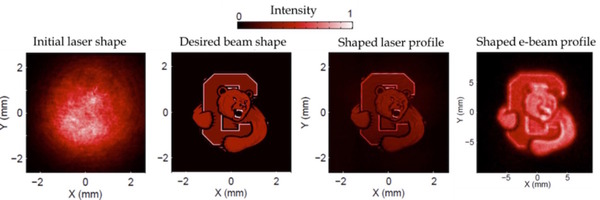CLASSE NEWS | 8 Mar 2015
 The researchers also think the methods they use for laser shaping could have an impact on fields beyond just particle accelerators. For instance, trapping of ultracold atomic gases also relies on the use of precisely shaped lasers, and the technique put forward by Jared Maxson would not only be applicable to that problem but is in fact much easier to implement than standard methods. For photoinjectors, it has been shown many times by simulations that an accurately shaped electron beam produces significant increases in beam brightness, and this work demonstrates that those high accuracy beam shapes can finally become an experimental reality.
These results have been published as an Editors' Suggestion paper in a Physical Review journal dedicated to accelerator science and as an Applied Physics Letter.
The researchers also think the methods they use for laser shaping could have an impact on fields beyond just particle accelerators. For instance, trapping of ultracold atomic gases also relies on the use of precisely shaped lasers, and the technique put forward by Jared Maxson would not only be applicable to that problem but is in fact much easier to implement than standard methods. For photoinjectors, it has been shown many times by simulations that an accurately shaped electron beam produces significant increases in beam brightness, and this work demonstrates that those high accuracy beam shapes can finally become an experimental reality.
These results have been published as an Editors' Suggestion paper in a Physical Review journal dedicated to accelerator science and as an Applied Physics Letter.
Laser Shaping Helps Produce Bright Beams
The electrons in any accelerator device have to come from somewhere. In the case of a photoinjector, like the one used at CLASSE, electrons from inside a special material called a photocathode are ejected into the accelerator interior by using an intense laser pulse to knock them out. However, the ability to eject electrons can change from place to place on the photocathode, either due to how the material was made, or from damage incurred during very high power beam running. This uneven electron yield can destroy the uniformity of the electron beam, which in turn reduces its brightness. CLASSE researchers headed by Jared Maxson (a PhD student in the professor Ivan Bazarov's group) have recently demonstrated that one can shape the laser beam adaptively to high enough accuracy to counteract any imperfections in the photocathode electron yield. To do this, they used a device called a spatial light modulator, which is little more than a very small array of liquid crystals, to shape test pulses of light. Once the concept was established, they were able to show the ability to generate electron beams of various shapes at high accuracy using these shaped laser pulses. The most stringent test of the device was to produce a beam whose profile was that of the Cornell Big Red Bear. The results of this experiment are shown in the figure below.
The original laser mode (left) is 'sculpted' to obtain the Cornell Big Red Bear logo with relativistic electrons using a photoemission gun (right). The electrons are visualized using a fluorescent screen.
